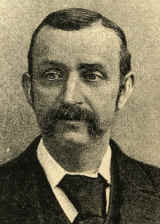History of water polo
[1][2] The rules of water polo were originally developed in the mid-nineteenth century in Great Britain by William Wilson, a British journalist, swimming instructor, and coach.
[4] The game originated as a form of rugby football played in rivers and lakes in England and Scotland with a ball constructed of India rubber, probably from the 1850s onwards.
Early play allowed brute strength, wrestling and holding opposing players underwater to recover the ball; the goalie stood outside the playing area and defended the goal by jumping in on any opponent attempting to score by placing the ball on the deck.
For example, in the South Eastern Gazette (in Kent; now closed), on Tues 28 July 1857, it says "An aquatic foot-ball match is fixed for to-morrow, Wednesday".
One of the earliest recorded games of a sport called ‘water polo’ occurred at the Crystal Palace (London), on 15 September 1873.
The Midland (of England) Counties Swimming and Aquatic Football Association probably set up the first water polo league in the world.
The first international water polo match was between England and Scotland at the Kensington Baths in London, on 28 July 1890.
[7] The England team were F Browne, WG Carrey, HF Clark, JF Genders, William Henry, J Finegan and JL Mayger.
The referee was Archibald Sinclair (who also founded the London Water Polo league) from Ranelagh Harriers, England.
By the 1880s, the game stressed swimming, passing, and scoring by shooting into a goal net; players could only be tackled when holding the ball and could not be taken under water.
In 1888, the sport was brought to the USA, by John Robinson, an English swimming instructor; by organising a team at the Boston Athletic Association.
Smith and Arnold Heilban started a team at the Sydenham Swimmers Club (later at the Metropole AC) in Providence, Rhode Island.
The first US championships were held on 28 January 1890, in Providence, when Sydenham Swimmers Club defeated Boston Athletic Association by 2:1.
Between 1890 and 1900, the game developed in Europe, spreading to Hungary in 1889, Belgium in 1890, Austria and Germany in 1894 and France in 1895, using British rules.
Such protests were rewarded when Australia won the gold medal match against the United States with a "buzzer-beater" last-minute goal, taken from outside the seven-meter line.
Many of the Hungarian athletes vowed never to return home, and felt their only means of fighting back was by victory in the pool.
The confrontation was the most bloody and violent water polo game in history, in which the pool reputedly turned red from blood.
A documentary by Lucy Liu, Freedom's Fury, premiered in April 2006, recounting the events of the 1956 Hungarian uprising and climaxing with this politicized game.
Prince William of Wales was the captain of his collegiate water polo team at St Andrew's University, Scotland.
The annual Varsity Match between Oxford and Cambridge Universities is the sport's longest running rivalry, first played in 1891.
Aniko Pelle (Hungary) and Sofia Konoukh (Russia) were among the first of an increasing number of international players competing in U.S. collegiate women's water polo.
A number of players, including former USA team captain Wolf Wigo, who retired after Athens 2004, Jacqueline Frank DeLuca, bronze medal Olympic goalie, and international phenom Tony Azevedo attended Stanford University.
The sport's most notable balancing act to date includes Omar Amr,[17] who played on the US National Team while attending Harvard Medical School and recovering from a near career ending knee injury in 2001.



